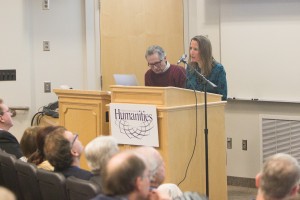Many people don’t think twice when they use words like “kaboom,” “roar” or “ho ho ho,” but a BYU linguistics professor does.
Janis B. Nuckolls, associate professor of linguistics, claims that these sound effect or onomatopoeia words are “elementally expressive” for all languages. Nuckolls explained how they allow humans to communicate more effectively during the annual James L. Barker lecture on Thursday.

Nuckolls used the example of speakers she’s studied from the South American Quechua language who use sound effect words heavily in their regular speech. She explained that Quechua speakers aren’t ashamed to use sound effect words, unlike some English speakers.
“Using sound effect words cause many English speakers embarrassment,” Nuckolls said. “Often, when a sound effect word does eventually evolve into a word, we still feel embarrassed to use it. … Even the sound effect words that do turn into perfectly legitimate words will face an uphill battle when judged by ordinary speakers.”
Nuckolls used an example from the children’s novel “Beezus and Ramona” to show how younger children, like Ramona, delight in using sound effect words but older children, like Beezus, feel foolish using them.
“Is it possible that Beezus’ objections to sound effect words stemmed from a complicated set of assumptions that are built into the standard, average English speaker’s culture?” Nuckolls asked.
She showed how culture has long resented the use of animal sounds in everyday language.
“Many of us, whether we are literary or scientific, are uncomfortable with personifications of nature,” Nuckolls said.
She quoted Frans De Waal, a renowned primatologist, who said, “To endow animals with human emotions has long been a scientific taboo. But if we do not, we risk learning something fundamental about both animals and us.”
Nuckolls added that even Joseph Smith taught that all of God’s creations, even a pebble, have a spirit. She said that her research on the speakers of the Quechua language show that speakers stretch their sounds to form sound effect words.

“They add (to) the existing system of the language by stretching sounds,” Nuckolls said. “By doing this, they embellish, adjust, stretch and tweak the language in very systematic and principled ways. So, sound effect words are not randomly thrown together with haphazard sounds.”
Nuckolls concluded by saying that sound effect words have a grammatical function within language. They add value to observing the finer details of the world, she said.
“We speak such a standardized version of a language that we are unable to appreciate our moment-by-moment perceptual experiences,” Nuckolls said. “It’s my hope that the next time you hear or read a sound effect word, whether it’s in the New York Times, in a children’s picture book or in a zany Youtube video about what foxes say, that you will take note of the fact that you are observing a type of word which has a long and respectable pedigree in the greater pantheon of human communicative possibilities.”




